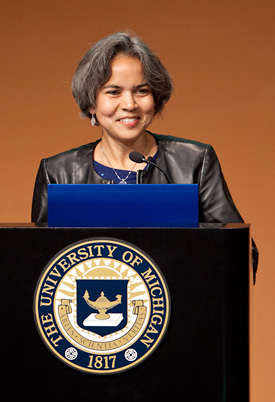The research tool of spatial-data analysis is key to discovering and addressing environmental risks to children’s health, Marie Lynn Miranda said March 26 in giving the 11th Annual Wege Lecture on Sustainability.
Miranda, the new dean of the School of Natural Resources and Environment, said such tools give both scientists and policy makers the ability to see obscure but possibly meaningful connections between a child’s environment and his or her health.

Marie Lynn Miranda, dean of the School of Natural Resources and Environment, delivers the 11th Annual Wege Lecture on Sustainability. Photo by Austin Thomason, U-M Photo Services.
The lecture drew on Miranda’s more than 20 years of research on the topic, and specifically her published work about lead contamination among children.
Using data collected in North Carolina, where much of her research to date has been conducted, she demonstrated the ability of mapping software to create richly linked maps from different data sets. These maps, often enhanced with other modeling and 3-D rendering techniques, make it possible to identify associations among previously separate variables.
In one example, she showed the location of churches and pharmacies, as well as data showing rates of lead poisoning among children, the age of homes in which they live, and family income. The separate data, when combined, offer policy makers and health-care practitioners new insights into how to serve families in which a child has higher-than-normal levels of lead contamination. The complexity of the data layers and the associations they offer help policy makers direct resources more effectively by targeting areas where the greatest need exists.
“Lead is one of those issues about which we feel ‘been there, done that,’” said Miranda, who grew up in Detroit. “But maybe we haven’t, and we need to take second look. What (the use of these tools) show is that even with documented lead exposure, you shouldn’t give up on kids.”
Miranda gave her address to about 450 people at Rackham Auditorium. The title of her lecture was “Fostering Environments to Sustain our Children’s Health.”
Much of the research was produced through the Children’s Environmental Health Initiative, a research, education and outreach program she founded while at Duke University. CEHI’s peer-reviewed work is cited widely, including in the U.S. Environmental Protection Agency’s current integrated science assessment on revisions to the national ambient air quality standard for lead.
Although it widely is agreed that child health and well-being are determined by multiple forces, surprisingly little is known about the interactions of those forces. For example, elevated environmental exposures often occur in communities facing multiple social stressors like deteriorating housing, inadequate access to health care, poor schools, high unemployment, high crime, and high poverty — all of which may compound the effects of environmental exposures. This phenomenon especially is severe for low income and minority children.
Miranda’s research and her Wege Lecture focused on how advanced information technologies are being used to determine the impact of combined social and environmental stressors on children — and how these same technologies can and are being used as the basis for deploying interventions that effectively create more protective environments for children.
Past speakers for the Wege lecture have included His Holiness the 14th Dalai Lama, former Vice President Al Gore, Ford Motor Co. Chairman Bill Ford Jr., and John Holdren, President Obama’s science adviser.
Established in 2001, the series honors Peter M. Wege, the retired vice chairman of the board of Steelcase Inc. in Grand Rapids. The event was co-sponsored by the Center for Sustainable Systems, the Department of Pediatrics at C.S. Mott Children’s Hospital, The Environment Report from Michigan Radio, Office of the Provost, Office of the Vice President for Research, School of Natural Resources and Environment, School of Public Health and the School of Social Work.

